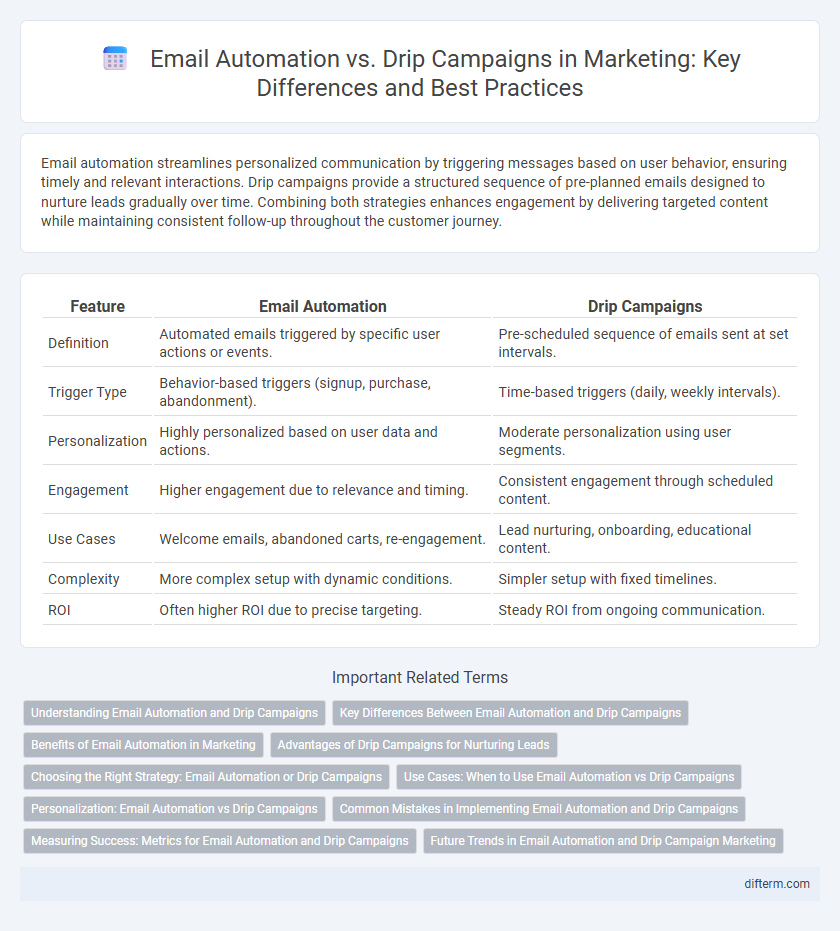Email automation streamlines personalized communication by triggering messages based on user behavior, ensuring timely and relevant interactions. Drip campaigns provide a structured sequence of pre-planned emails designed to nurture leads gradually over time. Combining both strategies enhances engagement by delivering targeted content while maintaining consistent follow-up throughout the customer journey.
Table of Comparison
| Feature | Email Automation | Drip Campaigns |
|---|---|---|
| Definition | Automated emails triggered by specific user actions or events. | Pre-scheduled sequence of emails sent at set intervals. |
| Trigger Type | Behavior-based triggers (signup, purchase, abandonment). | Time-based triggers (daily, weekly intervals). |
| Personalization | Highly personalized based on user data and actions. | Moderate personalization using user segments. |
| Engagement | Higher engagement due to relevance and timing. | Consistent engagement through scheduled content. |
| Use Cases | Welcome emails, abandoned carts, re-engagement. | Lead nurturing, onboarding, educational content. |
| Complexity | More complex setup with dynamic conditions. | Simpler setup with fixed timelines. |
| ROI | Often higher ROI due to precise targeting. | Steady ROI from ongoing communication. |
Understanding Email Automation and Drip Campaigns
Email automation streamlines personalized messaging by triggering emails based on user actions or predefined schedules, enhancing customer engagement at scale. Drip campaigns deliver a series of targeted, time-sequenced emails designed to nurture leads and guide prospects through the sales funnel. Both strategies leverage behavioral data and segmentation to optimize open rates, click-through rates, and conversion metrics in email marketing.
Key Differences Between Email Automation and Drip Campaigns
Email automation streamlines personalized message delivery based on specific triggers or user actions, enhancing real-time engagement. Drip campaigns follow a predetermined sequence of pre-scheduled emails designed to nurture leads gradually over time. The key difference lies in automation's adaptability to individual behavior, whereas drip campaigns maintain a fixed timeline regardless of recipient interaction.
Benefits of Email Automation in Marketing
Email automation streamlines marketing efforts by delivering personalized content based on customer behavior and preferences, increasing engagement and conversion rates. It allows for real-time segmentation and timely follow-ups without manual intervention, saving valuable time and resources. Automated workflows improve customer retention by nurturing leads consistently, driving higher ROI compared to traditional drip campaigns.
Advantages of Drip Campaigns for Nurturing Leads
Drip campaigns provide a strategic advantage in nurturing leads by delivering personalized, timely content that aligns with the buyer's journey, increasing engagement and conversion rates. Automated sequences in drip campaigns enable consistent communication without overwhelming the recipient, fostering trust and brand loyalty over time. Their ability to segment audiences and trigger emails based on user behavior ensures relevant messaging that drives higher ROI in marketing efforts.
Choosing the Right Strategy: Email Automation or Drip Campaigns
Email automation enables personalized, real-time responses based on user behavior, enhancing customer engagement and conversion rates. Drip campaigns deliver pre-scheduled, sequential messages designed to nurture leads over time, ideal for long-term relationship building. Selecting the right strategy depends on campaign goals; automation suits dynamic, event-triggered interactions, while drip campaigns excel in structured, time-based communication workflows.
Use Cases: When to Use Email Automation vs Drip Campaigns
Email automation suits trigger-based marketing where personalized, timely responses depend on user actions, such as cart abandonment or welcome sequences. Drip campaigns excel in nurturing leads with a pre-planned series of content designed to educate and convert over time, ideal for onboarding or long-term engagement. Choosing between email automation and drip campaigns hinges on campaign goals, timing precision, and the level of interaction customization needed.
Personalization: Email Automation vs Drip Campaigns
Email automation enables highly personalized messaging by leveraging customer data to trigger timely, relevant emails based on specific actions or behaviors. Drip campaigns follow a predetermined sequence of emails with limited flexibility in personalization, often relying on generic user segments. Businesses aiming to enhance customer engagement should prioritize email automation to deliver tailored experiences that improve open rates and conversion.
Common Mistakes in Implementing Email Automation and Drip Campaigns
Common mistakes in implementing email automation and drip campaigns include sending irrelevant or overly frequent emails that lead to subscriber fatigue and high unsubscribe rates. Failing to segment the email list properly results in generic messaging that reduces engagement and conversion rates. Neglecting to analyze campaign performance metrics prevents marketers from optimizing sequences, ultimately diminishing the overall effectiveness of the automation strategy.
Measuring Success: Metrics for Email Automation and Drip Campaigns
Measuring success in email automation involves tracking open rates, click-through rates, and conversion rates to evaluate engagement and ROI effectively. Drip campaigns require analyzing subscriber retention, email sequence performance, and lead nurturing metrics to optimize content delivery and timing. Both strategies benefit from A/B testing and engagement scoring to refine targeting and improve overall campaign effectiveness.
Future Trends in Email Automation and Drip Campaign Marketing
Future trends in email automation and drip campaign marketing emphasize hyper-personalization powered by AI and machine learning algorithms that analyze user behavior in real-time for dynamic content delivery. Integration with multi-channel marketing platforms enhances customer journey orchestration, enabling seamless synchronization across email, social media, and SMS. Predictive analytics and data-driven segmentation optimize send times and message frequency, maximizing engagement and conversion rates.
email automation vs drip campaigns Infographic

 difterm.com
difterm.com